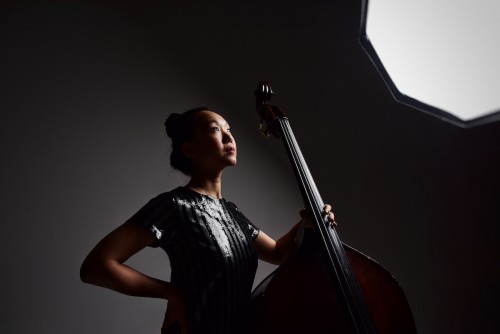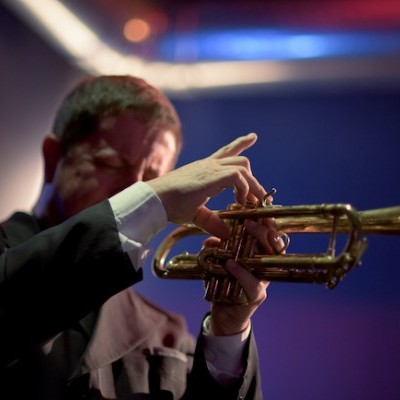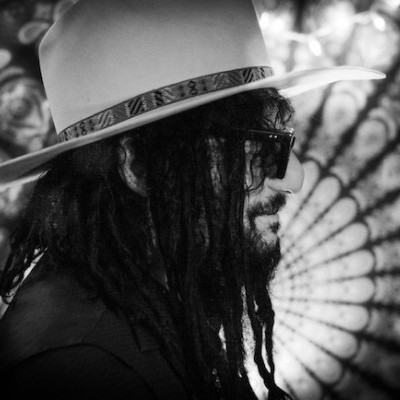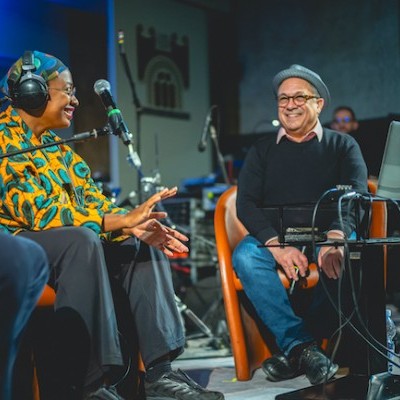Jul 9, 2024 11:35 AM
Trumpeter, Educator Jim Rotondi Dies at 61
Jim Rotondi, a renowned hard-bop trumpeter, composer and educator, died suddenly on July 7 at a hospital in France. He…

Bassist and bandleader Linda May Han Oh calls Aventurine her most ambitious compositional work to date.
(Photo: Shervin Lainez)Linda May Han Oh has gotten used to carrying her double bass up the four flights of stairs to the Harlem walk-up she shares with her husband, pianist Fabian Almazan.
No doubt she’s had lots of practice of late. Besides composing for and performing with her multiple ensembles, she’s been touring internationally with guitarist Pat Metheny’s quartet and teaching at The New School in the West Village. She recently released her fifth album as a leader, Aventurine, on Almazan’s Biophilia Records, and is actively engaged with the label’s social mission: to create meaningful music with other environmentally aware artists. Despite the demands of a burgeoning career and hectic schedule, however, Oh’s demeanor remains composed, even graceful.
Her ability to manage complexity contributes in no small part to her swift rise as a creative musician during the past decade. In the years since Oh graduated from Manhattan School of Music with a master’s degree in 2008, commendations for her captivating performances and clean, melodically driven compositions have poured in: a semifinalist spot at the 2009 Thelonious Monk Institute of Jazz International Bass Competition, the Jazz Journalists Association’s nomination for up-and-coming artist of the year in 2010, winner of the category Rising Star–Bass in the 2012 DownBeat Critics Poll, a Jazz Gallery commission that same year and a Jerome Foundation Fellowship in 2016. As these accolades accrued, some of the biggest names in jazz started to tap Oh as a side-player: drummer/producer Terri Lyne Carrington, saxophonist Joe Lovano, and pianists Vijay Iyer, Kenny Barron and Geri Allen (1957–2017).
When it comes to her craft, Oh is a driven, conscientious collaborator—and easy to work with, to boot. “Linda is one of the best people you could ever meet,” asserted Aventurine alto saxophonist Greg Ward, whose admiration for Oh’s abilities only has grown during the eight years he’s been working with her. “And [as a musician], she keeps getting better and better.”
The groundwork for Oh’s success was laid early, half a world away from Harlem. Born in Petaling Jaya, Malaysia, Oh moved with her family at age 3 to Perth, Australia—not the typical launching pad for an international music career. “Perth is pretty much the most isolated major city you can find,” the bassist said in a recent interview.
Even so, Oh’s mother made sure that she received top-notch music instruction, starting with classical piano lessons in the Yamaha method at an early age. From the rigors of this initial training, Oh moved on to play bassoon and clarinet in school bands before picking up the electric bass—and metal, rock and alternative chops with it—at age 15. From there, it was a short step to the upright bass and jazz.
“I come from a traditional Chinese household where we learned classical music in a regimented program. Some of the teachers were pretty hard—we had many competitions, and there was a lot of pressure. That training set the foundation for things, though, and after that it was about discovering other types of music, all of which influence how I write and put music together today,” she asserted.
As one track segues smoothly into the next on Aventurine, listeners can hear the multivariate influences of Oh’s broad cultural and musical experiences. Her instrumentation features a genre-bending octet: a modern jazz rhythm section (Oh, pianist Matt Mitchell and drummer/vibraphonist Ches Smith), a string quartet (violist Benjamin von Gutzeit, cellist Jeremy Harman, and violinists Sara Caswell and Fung Chern Hwei) and saxophonist Ward. In addition, for the first time, Oh is writing for a chorus—a quintet led by Australian singer Gian Slater, of vocal ensemble Invenio.
To make full use of all that talent, Oh’s compositions can reach wholesale across the musical spectrum. In her writing, she might use classical orchestration, jazz grooves and contrasting improvisatory styles, and her sources can range from Baroque music to jazz standards to traditional Asian melodies. What for many musicians would be an almost unwieldy surfeit of options, for Oh is a well-practiced juggling act.
“With this music, I had different challenges in mind. I was wondering how I was going to roll with an idea and push it to the nth degree,” she said about the new album. “On ‘Song Yue Rao,’ for example, I was taking one theme and trying to develop it in a way that’s interesting. The questions were, How does it develop? Where does it go? Where do you want to take someone?”
“Song Yue Rao” derives from a simple Chinese folk song, typically performed by a singer-storyteller accompanied by hand percussion. On the track, Oh cycles through the short, bouncing melody as she would a jazz head, but in counterpoint and different keys. After opening with the melody in the bass and violin, the tune quickly expands into a fascinating modern jazz composition revolving disjointedly around this recurring theme, concluding with a sinewy saxophone solo that ventures far from the original tune.
Oh approaches Charlie Parker’s classic bebop blues “Au Privave,” the only standard on the album, with similar shifts in key—this time adding rhythmic variations and looping improvisations. The task at hand was to find a way to unify five different melodies in four keys, in much the same way J.S. Bach unified two measures in different keys in a fugue section of Clavier-Übung III. But Oh demurs at the suggestion that this approach reflects some kind of brilliance.

Jim Rotondi was acclaimed for his wide, round trumpet tone, remarkable virtuosity and assured swing.
Jul 9, 2024 11:35 AM
Jim Rotondi, a renowned hard-bop trumpeter, composer and educator, died suddenly on July 7 at a hospital in France. He…

Charles Lloyd, seen here at the 2024 New Orleans Jazz & Heritage Festival, makes DownBeat Poll history!
Jul 11, 2024 12:23 PM
The incomparable Charles Lloyd swept the 72nd Annual DownBeat Critics Poll, becoming the first artist ever to earn…

“Being president of Blue Note has been one of the coolest things that ever happened to me,” Was said. “It’s a gas to serve as one of the caretakers of that legacy.”
Jun 4, 2024 12:21 PM
Sitting with Don Was is a comfortable and unhurried exercise. He may seem slightly reserved at first, but ideas and…

“She reminds me of my childhood and makes we want to cry,” Cécile McLorin Salvant, pictured here with writer Ashley Kahn, said of Dianne Reeves.
Jun 11, 2024 12:31 PM
Italy’s Umbria Jazz Winter is one of those rare annual festivals that not only coincides with a major holiday —…

Maria Schneider said of Decades, her new compilation release: “I just wanted to create something, put it in a beautiful box and say, ‘Look at what we did.‘”
Jun 18, 2024 12:00 PM
Maria Schneider opened the sleek black box and placed it on a coffee table in her Manhattan apartment. Inside lay the…